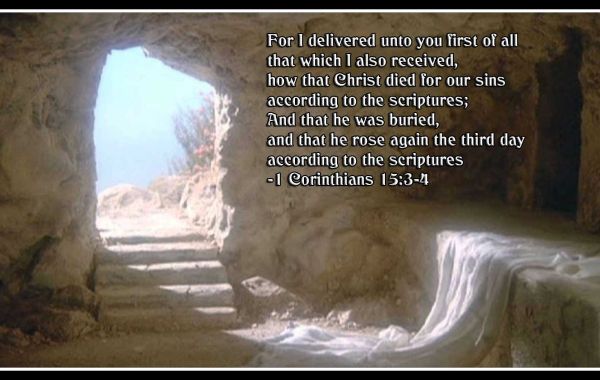3 For I delivered unto you first of all that which I also received, how that Christ died for our sins according to the scriptures; 4 And that he was buried, and that he rose again the third day according to the scriptures: 5 And that he was seen of Cephas, then of the twelve: 6 After that, he was seen of above five hundred brethren at once; of whom the greater part remain unto this present, but some are fallen asleep. 7 After that, he was seen of James; then of all the apostles. 8 And last of all he was seen of me also, as of one born out of due time.
Eyewitnesses to The Gospel
Paul begins by stating that the resurrection is a vital, essential part of the Gospel. Vs. 2 By which also ye are saved, if ye keep in memory what I preached unto you, unless ye have believed in vain.
Then we hear the classic definition of the Gospel in the four that’s starting in 1 Corinthians 15:3-5
3 that Christ died for our sins, 4 that he was buried, that he rose again, 5 that he was seen by many eyewitnesses
The Gospel, the Good News, is the death, burial and resurrection of Jesus Christ. This is what Paul received and believed it is what he preached to the Corinthians, and they believed. The Gospel is perfectly balanced on this tripod of truth. If you take away the death on the cross, or the three days in the tomb, or the resurrection from the grave then the Gospel tripod can’t stand. It collapses and a collapsed Gospel can’t save anyone.
And if you don’t believe or you deny any part of the Gospel then as Paul warned the Corinthians, you believed in vain. You believed in emptiness, nothingness.
Next Paul goes to the heart of this chapter, the question that he must deal with, the proof of the resurrection and then the necessity of believing in the bodily resurrection of Christ and our own resurrection through Him.
He gives the eyewitness accounts, and they are numerous and verifiable for they happened only about 25 years prior to the this letter. 1 Corinthians 15:5-8
he was seen of Cephas (the Aramaic word of Rock, Petros in Greek),
then of the rest of the twelve (he names them as a group even though Judas was no longer with them):
6 After that, he was seen of above five hundred brethren at once; of whom the greater part remain unto this present, but some are fallen asleep.
7 After that, he was seen of James (the brother of Jesus and as Paul is writing this epistle, James is the pastor of the church at Jerusalem);
then of all the apostles. (this word means “sent ones” and probably refers to those who walked with Christ during his earthly ministry. Probably the seventy He appointed and sent out in Luke chapter 10.)
8 And last of all he was seen of me also, as of one born out of due time. (Paul says his birth and his apostle ship was like a miscarriage, that is what the Greek word means. Not that was harmful but that it came at an unexpected time, a late birth in this case.)
Eyewitness Still Convincing
If we would judge the story of the resurrection by the same standard we would judge any historical narrative then we find that it cannot be a myth, much less a lie for it has evidentiary proof. One of the strongest of those proofs is the eyewitness testimonies of the witnesses who saw Jesus alive. But why should we still believe them after all these centuries?
Chuck Colson, the famous Watergate figure, gives the reason.
“I know the resurrection is a fact, and Watergate proved it to me. How? Because 12 men testified they had seen Jesus raised from the dead, then they proclaimed that truth for 40 years, never once denying it. Every one was beaten, tortured, stoned and put in prison. They would not have endured that if it weren't true. Watergate embroiled 12 of the most powerful men in the world - and they couldn't keep a lie for three weeks. You're telling me 12 apostles could keep a lie for 40 years? Absolutely impossible.” - Charles Colson
Many other famous people have set out to disprove the Bible and Christianity and often it is the strength of the testimonies of the eyewitnesses that still convinces them.
Gilbert West (1703-1756) was one of the Most Eminent English Poets in his lifetime. As a student at Oxford, West set out to debunk the Bible’s account of Christ’s resurrection. Instead, having proved to himself that Christ did rise from the dead, he was converted. West published his conclusions in the book “Observations on the History and Evidences of the Resurrection of Jesus Christ” (1747).
George Lyttelton (1709-1773) was an English statesman, author, and poet, educated at Eton and Oxford. As a young man he set out to prove that Paul was not converted as the Bible states. Instead, he wrote a book containing evidence that Paul was indeed converted and that his conversion is evidence that Jesus rose from the dead. The book was titled “Observations on the Conversion and Apostleship of St. Paul” (1747).
Albert Henry Ross (Frank Morison) (1881-1950) After becoming a lawyer he set out to write a book to disprove the resurrection of Jesus Christ. Instead, he was converted and wrote a book in defense of the resurrection entitled WHO MOVED THE STONE? - which is still in print today.
Simon Greenleaf (1783-1853) Simon Greenleaf, Royall Professor of Law at Harvard University, was one of the most celebrated legal minds in American history. His Treatise on the Law of Evidence “is still considered the greatest single authority on evidence in the entire literature of legal procedure.” As a law professor, he determined to expose the “myth” of the resurrection of Christ once and for all, but his thorough examination forced him to conclude, instead, that Jesus did rise from the dead. In 1846 he published “An Examination of the Testimony of the Four Evangelists by the Rules of Evidence Administered in the Courts of Justice.”
Lee Strobel has a law degree from Yale University and worked as an investigative reporter for one of America’s largest newspapers, the Chicago Tribune. He was an atheist. After his wife became a Christian in 1979, he was upset at her decision and determined to prove that the Bible is not true and that Jesus Christ is not the Son God. For two years he pursued this objective, using all of his legal and journalistic skills, but in the end he had proved to himself that the Bible is the Word of God and Jesus rose from the dead. He became a Christian in 1981 and has since written many books defending the Christian faith, most famous is The Case for Christ: A Journalist’s Personal Investigation of the Evidence for Jesus, 1998.
We could go on citing scholar after scholar, author after author who after examining the evidence of the eyewitness accounts came away convinced that those witnesses had to be telling the truth. And if they spoke the truth, then the resurrection of Jesus was real and all of time and history hinges on that truth.







